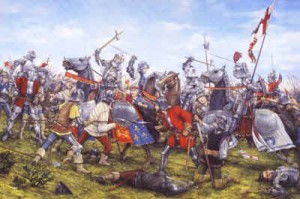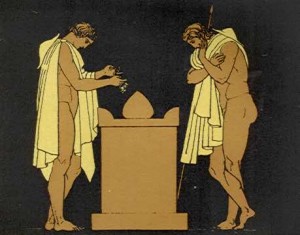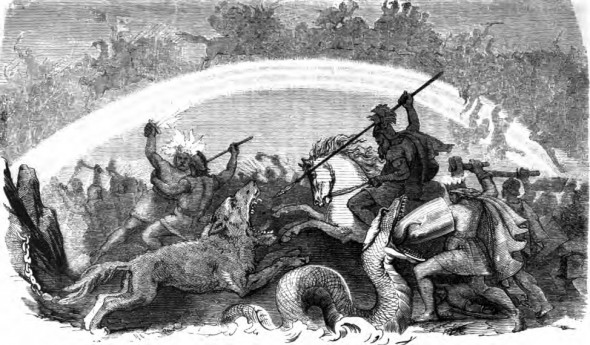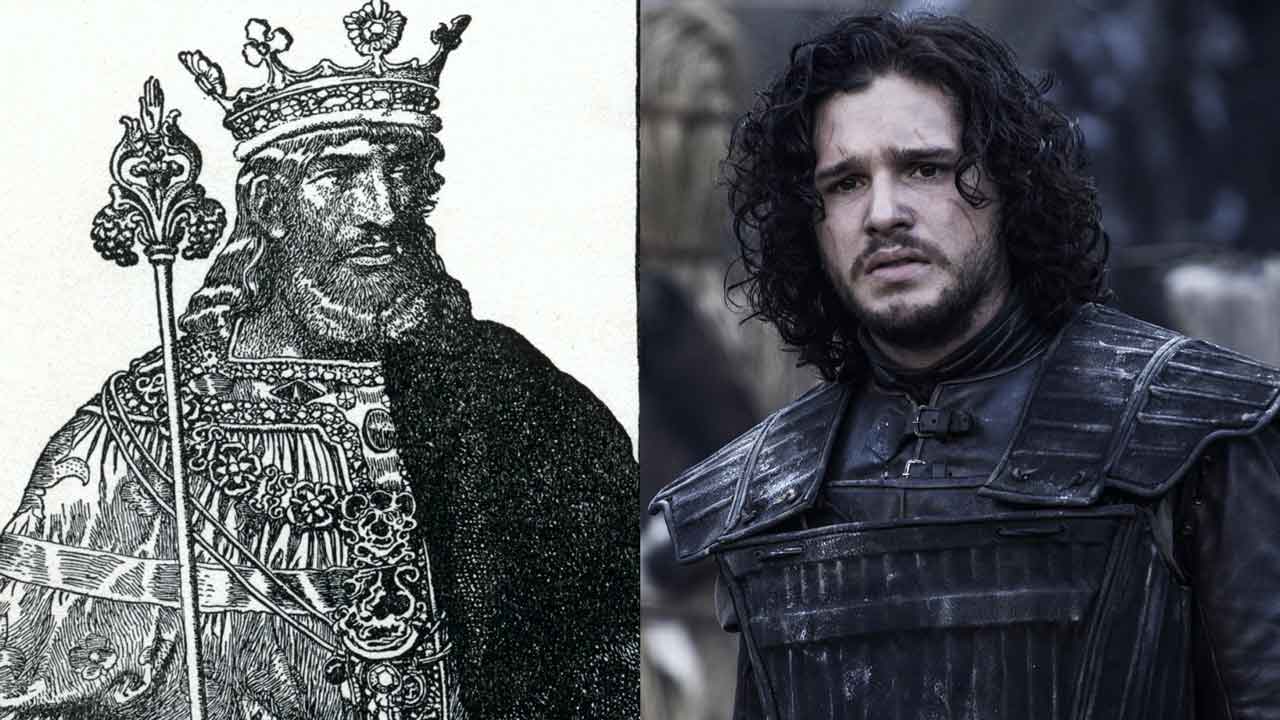[This post has spoilers for the Game of Thrones TV show through season 5, episode 2. Is spoiler-free for the books past that point in the story.]
In our latest Game of Thrones TV Recap podcast (iTunes, RSS) on “The House of Black and White” (season 5, episode 2), I mentioned that Jon Snow’s election as Lord Commander of the Night’s Watch at climax of that episode was reminiscent of the Roman-influenced historical and mythological election of Arthur as king of the post-Roman, Celto-Brtiannic warlords; that the equality of the Night’s Watch with regards to each other was reminiscent of the Knights of the Round Table; and that, with his Valyrian steel longsword Longclaw at hand, Jon Snow might eventually develop into a King Arthur figure.
I wanted to elaborate a bit on what I meant by all that, and how I think correspondence and reference to historical and legendary figures and events work in the Game of Thrones universe, both in the show and the books. Because it’s not so simple. The characters in Game of Thrones definitely map onto different mythological traditions and historical events, but it happens in various complex and interconnected ways.
As you study it and find your “eureka” moments, where a specific source smacks of familiarity, what emerges is a “story of stories” plan in George R.R. Martin’s magnum opus. It’s very modern, almost Vorticist; everything is connected, and the more you look, the more things are connected.
The Historical, Mythological, and Literary Sources of Game of Thrones
In no particular order, these sources include the British Wars of the Roses, the Oresteia tragedies by Aeschylus, the Prose Edda and the Norse myth of Ragnarok, Arthurian legend, obviously some dose of larger European politics, obviously some bits here an there of Zoroastrianism, perhaps some fairly specific references to traditional Spanish mythology, and others. The phrase “the dragon has three heads” is taken directly from pre-Muslim Persian myths.
There’s a great short-lived blog: Game of Thrones & Norse Mythology, with a lot of great writing on the Norse mythological connections (and some dubious plot predictions based on them) between the various wolves and gods who participate in Ragnarok, but the Arthurian associations are I think generally less fleshed-out by the online commentariat. At least, I haven’t yet seen the definitive source on the matter.
This is particularly because a lot of it relates to events pretty late in the story, events the show is only getting to now, like Jon Snow being elected Lord Commander of the Night’s Watch, or Brienne’s quest to find Sansa and Arya (a chaste Galahad’s quest for a Girl instead of a Grail), or Melisandre showing up at the Wall, giving us our Morgana le Fey. As the story goes on it’s possible the characters who are far apart from each other might eventually come back together, making relationships like this jump out.
It’s generally thought that the idea of the Wall in the North is related mytho-historically to Hadrian’s Wall in Britain, which would place the Knights of the Round Table more or less in a corresponding place geographically. And let’s watch to see if the show ever has a “Sword in the Stone” moment. The books seem to be headed in that direction if you ask me, but in ways the show can’t do because it has cut a bunch of the relevant characters and left out a bunch of the relevant lore. But they may figure out a way to do it all the same.
Rules for Reading
And as you piece all this together, several rules emerge that seem to govern how it all works. And as somebody who isn’t sure which of these interpretations is “right,” but is pretty sure of a method of interpretation, here are the rules:
First, we do not know how the story ends yet, so a lot of this is speculative, and the relationship with textual evidence gets fluid. These are ideas living behind or within ideas. It can feel like you’ve cracked a code when a whole bunch of relationships fall into place, but it doesn’t behave like a code all the time. It bends and twists, and it shouldn’t really be approached with a logically positive skepticism. More with a sense of the poetic. If this pursuit is about anything, it’s about making the story richer.
The stories in the books don’t necessarily turn out the same way as the stories they reference. But when they are different, there’s usually something interesting about the difference. The myths and stories are often exploded and fragmented across several plot lines in the books and a lot of characters. So they don’t line up one to one.
And sometimes they also imply further information that is not revealed yet. For example, if a given source story relies on one character having a family relationship they don’t appear to have, maybe entertain the possibility that they have this relationship, but it’s not known to the reader (this happens a lot).
Multiple characters in Game of Thrones can correspond to different aspects of the same historical/mythological figure, and multiple historical/mythological figures can be expressed through the same Game of Thrones character.
Plots to Watch Out For
If I had to parse it out by plotline, I’d say:
 The story of the political intrigue and war between the Starks and the Lannisters is the story of the British War of the Roses, between York and Lancaster. In this light, the Targaryan conquest stands in for the Norman Invasion in 1066, and Daenery’s hope of a Targaryan reconquest as the potential advent Henry Tudor, the last King of England to win the crown on the battlefield.
The story of the political intrigue and war between the Starks and the Lannisters is the story of the British War of the Roses, between York and Lancaster. In this light, the Targaryan conquest stands in for the Norman Invasion in 1066, and Daenery’s hope of a Targaryan reconquest as the potential advent Henry Tudor, the last King of England to win the crown on the battlefield.
 The story of the internal struggles in the Lannister family and of Tyrion specifically is the Orestia. Cersei is the Clytemnestra figure, furious at the sacrifice of her children, murdering her husband the king when he is incapacitated, having an extended affair under his nose, and Tyrion is an Orestes figure, pursued by the Furies and seeking out an Elektra to assist him in final vengeance.
The story of the internal struggles in the Lannister family and of Tyrion specifically is the Orestia. Cersei is the Clytemnestra figure, furious at the sacrifice of her children, murdering her husband the king when he is incapacitated, having an extended affair under his nose, and Tyrion is an Orestes figure, pursued by the Furies and seeking out an Elektra to assist him in final vengeance.
The story of the Night’s Watch battling the Wildlings and attempting to deal with the political situation in the North is the story of King Arthur and the Knights of the Round Table. Perhaps Stannis is an Uther Pendragon figure, as this story only seems to come into its own as he arrives at the wall. King Arthur was a bastard, and the best-known historian to write about Uther Pendragon was named Geoffrey, another name kicking around the series somewhat dissociated from its source, but still part of the vocabulary.

The story of the ultimate fate of the world, and of the Stark siblings, with the ice monsters coming from one side, and the dragons coming from the other side, and R’hllor the fire god, and the giant magical tree at the ends of the Earth with the one-eyed god who commands Ravens, is the story of the Ragnarok from Norse mythology. There’s tons of evidence of these stories kicking around in the background, but perhaps the clearest, other than Hodor (“Hodor.”), is that the name of the Norse source George R. R. Martin most likely used is the Prose Edda, and of course the first protagonist of the series is named Eddard.
The Problem with Predictions
It’s fun and popular to use literary references to make predictions about the plot of the story, and I encourage you to try it (I really like doing it). But remember that being influenced by an artist is also a process of hoping to surpass and destroy an artist. And George R. R. Martin loves to alternatively embrace and defy genre and precedent. So don’t be surprised if your analysis leads you to think events will proceed a certain way, and then he pulls the rug out from under you.
He does love doing that, as much as we love having it done to us.
Have at it: share your own thoughts on the mytho-historic referents of Game of Thrones and Song of Ice and Fire in the comments. But remember: mark spoilers clearly for events beyond the most recently-aired television episode and the corresponding point in the books, and please mark as spoilers things from the books that don’t happen in the series, but might reveal something viewers don’t know.

“but perhaps the clearest, other than Hodor (‘Hodor.’)”
Oh god. Does this mean that Hodor is going to accidentally kill Bran? (with or without mistletoe?) I can’t imagine that happening, but I don’t know who else would represent Baldr, and I don’t think that Hoder does anything else interesting in Norse mythology.
Thinking about how the names are a degree or so removed a lot of the time — you can see Joffrey as Baldr and Sansa as Hodur — Sansa is the unwitting participant the assassination of a golden beautiful dude whose mother protects him from everybody.
But of course Hodor resembles Hodur more superficially. And there is another thing…
The other thing Hodur does is unknowingly serve Loki. If you break the Lannister/Stark feud down into “team sun” versus “team wolf,” then Loki is on team wolf, and Hodur is going along with what team wolf wants from him without really being aware of what is happening.
This dimension is heightened a bit when you consider that Hodor is probably related to the Freys (since his real first name is probably Walder, and the Freys name like every other kid some variant of Walder), and if he participates in the death of Walder Frey in some way (which doesn’t seem that farfetched), he would be kinslaying, which is another thing Hodur does.
The death of Walder Frey will I think be a hugely important event in the story — it could happen any number of ways, and the way it happens will I think solidify some of the otherwise kind of floaty themes and ideas in the story.
*References events in Books 3/4 that weren’t (yet?) in the show but only speculates for stuff beyond ep 2*
Another mythical parallel is the Sansa and Littlefinger plot and the story of Persephone and Hades. Hades abducts Persephone from a garden with the intention of taking her as a bride. He offers her a pomegranate and then remains in hades (for part of the year) as goddess of the underworld.
But there’s also inversions of this myth. Rather than going from Mt Olympus to the depths of hades, they go up to the Vail. Sansa also refuses Littlefinger’s pomegranate.
1. There’s a fan theory out there that Sansa was/will be raped by Littlefinger, and considering how much this myth deals with a violent male sexuality imposing itself on an innocent female sexuality, I think there might be something there. However, I’m expecting some kind of inversion of that. I have some faith that this could be handled well in the books, but last season has me a bit concerned with how the show would approach it.
2. There’s a pretty clear Demeter analogue in the books that hasn’t been in the show. Considering Demeter’s relationship with winter, I can’t help but wonder if that is a hint that the circumstances surrounding the very existence of this character is tied to the Others/White Walkers.
3. The direction the show is taking seems to be pushing Brienne into a Theseus type role. It makes me wonder what would cause her to loose her sense of duty and honor. Or perhaps there’s another inversion waiting.
How is Brienne like Theseus? I hadn’t heard that before, and I’m curious about it.
Well it is more speculation based on how the show is moving Brienne and Pod’s story. If I’m remembering my mythology correctly (I can’t verify it right now) Theseus and a companion go to rescue Persephone from the underworld. However, they rest on some cursed chairs that cause them to forget who they are. They remain sitting on the chairs until Theseus is eventually rescued by Hercules. Though I think the version I heard as a kid presented Theseus as a hero trying to do the right thing, the adult version had far less noble intentions.
So, my speculation is that in Brienne’s quest to save Sansa, she will loose her sense of self by either joining the Boltons (who killed Catelyn) or Stanis (who killed Renly, and more likely where the show is going).
What’s the reference to traditional Spanish mythology? I read the Xana link; I don’t understand what it’s connected to in the books.
SPOILERS SPOILERS SPOILERS LOOK AWAY —
It’s the story of Quentyn Martell, which of course we probably aren’t going to get in the show, because all signs show the character has been cut.
In my first draft of this I wrote more on it, and I couldn’t find one website that explained all of it, but then I cut it way down and just kept in one link and it doesn’t really make sense. I should have linked to this wikipedia page instead:
http://en.wikipedia.org/wiki/Cu%C3%A9lebre
I found it when I was looking for references to dragons and snakes in Arabian and Spanish mythologies. It comes together in a cool way. It might be a case of me reading too much into it, maybe.
It’s interesting to consider how many different ideas of what a “dragon” is in world mythologies show up in the series. This version of a “dragon” refers in the books specifically to Rhaegon and Viseryon, Daenerys’s dragons that are chained up beneath Mereen because Drogon killed and ate people’s livestock and eventually children.
The “Cuelebre” is a “Snake-Dragon” — they are dangerous monsters that eat people and livestock, but they spend most of their time holed up in caves, where they slowly grow tougher and stronger. They keep “xanas” as prisoners – beautiful blonde-haired water nymphs.
If you go into the cave and kill the ceulebre to rescue the xana, then maybe the xana will find favor with you and bestow on you riches.
But xana – water spirits – are only sometimes good. Sometimes they are nasty and steal children. They have monster children that they make other people raise as their own. They have a sort of “siren song” ability that has different effects on the pure and impure.
So, the way I see this working out in the story is that the Martells are in search of a “Snake-Dragon” — a queen who will help them destroy the Lannister/Tyrell/Baratheon regime and gain vengeance for the death of Elia Martell.
It’s a Snake because in the story the Snake represents the violent, vengeful side of the Martells. The merciful, life-valuing, child-raising side of the Martells is represented by water (The water gardens, specifically, which I’m convinced have to either freeze over or be burned down by the end of the story as a consequence of the pursuit of Snake ambitions).
So, Quentyn Martell in the books is not a Snake Martell – he’s a Water Martell. He’s peaceful. He doesn’t want vengeance. He is in love and more than anything he wants to settle down and have children.
But, he is convinced that out there is a beautiful blonde woman he can bring home to the water gardens, marry, and raise children with. He is drawn to her, he wants to go despite himself — but when he gets there, she doesn’t want him, and she’s already married.
So, he defaults to tales and myths of adventure – he figures he needs to go down into the dragon pit and prove he is worthy of her – almost as if he is resucing Daenerys from her own dragons. But instead of taming the dragons, he is burned alive and dies tragically, and the dragons are set loose on the city.
The Martells are also pursuing the siren’s song of another blonde girl (that there are two different Martells pursuing two different blonde girls is what gives me the extra sense that this might be on the right track) – Myrcella Baratheon/Lannister. She’s also kind of an unknown quantity – she’s also associated with the Water Gardens; that’s where we see her first in Dorne. She has a certain siren’s song to her for Arianne Martell (who is also not in the story).
I won’t go into where that story goes, becuase Myrcella’s plotline will probably be in the show more heavily, since they recast her rather than cut her, but it all connects – blonde women, water, dragons, snakes, all that stuff.
But yeah, I found all that stuff and it seemed to me too connected to be entirely an accident. Dorne is modeled at least a little bit on Spain, so it makes sense for there to be something else Spanish associated with them.
It’s also worth noting that there is an Asturian ritual associated with the xana – if you think you are raising children that are not your own, left to you by a xana, you put eggshells by the fire, and it’s supposed to reveal the truth.
If GRRM ever had the xana in mind, then maybe Daenerys putting her dragon eggs by the fire is pulled from that.
But that seems kinda like a real stretch, even for me.
Here’s an adorable unsourced website, in which the girl literally becomes a dragon until a brave hero wih a pure heart convinces her to be a girl again.
So I’m probably off on some specifics of the myth, but I don’t speak Spanish so it’s hard to find sources. It still feels like the kind of story Quentyn Martell would believe in as he tragically misunderstood both Daenerys and the world he lived in.
http://www.dragnix.net/Legends/the_cuelebre.html